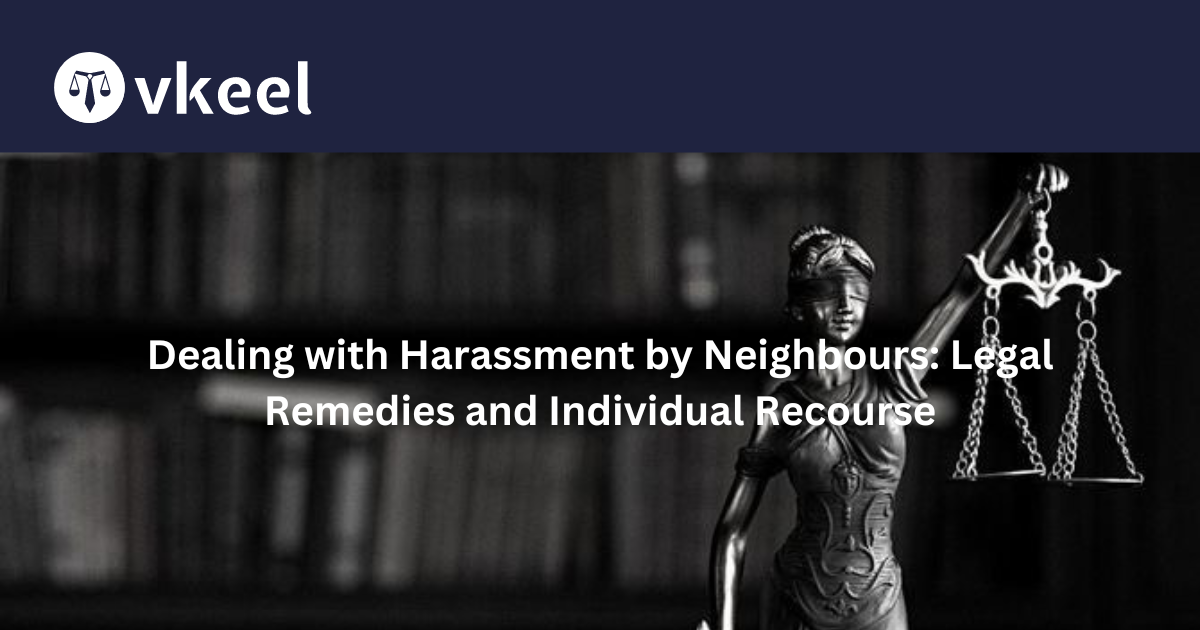Dealing with Harassment by Neighbours: Legal Remedies and Individual Recourse
By Himanshu Kumar
Table of Contents
Introduction
Harassment is a form of behavior that involves unwanted, persistent, and often repeated actions or communication that cause distress, discomfort, or fear in the targeted individual. It can occur in various settings, including the workplace, educational institutions, public spaces, and neighborhoods. Harassment can take many forms, ranging from verbal abuse and intimidation to physical aggression and online stalking.
Harassment is not limited to a single incident but often occurs repeatedly over time, creating a pattern of behavior that perpetuates the harm inflicted on the victim. It is important to recognize that harassment can occur in various contexts and can target individuals based on their race, gender, sexual orientation, religion, disability, or other personal characteristics.
The impact of harassment on the victim can be profound, leading to feelings of fear, anxiety, depression, and low self-esteem. It can also have detrimental effects on the victim’s physical health, relationships, and professional life, leading to absenteeism, reduced productivity, and even job loss in severe cases.
Addressing harassment requires a multi-faceted approach that involves both preventative measures and responsive interventions. This includes implementing anti-harassment policies and training programs in organizations and institutions, providing support services and resources for victims, and holding perpetrators accountable through legal and disciplinary actions.
Ultimately, combating harassment requires a collective effort from individuals, communities, and institutions to foster a culture of respect, dignity, and equality, where harassment in any form is not tolerated, and all individuals are able to live and work free from fear and intimidation.
Living in a neighborhood can be a harmonious experience, with neighbors sharing joys and sorrows, and forming a supportive community. However, sometimes this harmony is disrupted by harassment from neighbors, which can take various forms such as noise disturbances, privacy invasion, property damage, or even verbal and physical abuse. When faced with such situations, individuals need to be aware of their legal rights and available remedies to address the issue effectively.
Types of Harassment
Following are the types of harassment:
Verbal Harassment
Verbal harassment involves the use of words, gestures, or expressions to demean, insult, threaten, or intimidate an individual. This can include derogatory comments, racial slurs, sexual innuendos, or persistent criticism aimed at undermining the target’s confidence and self-esteem.
Example of Verbal Harassment
A coworker repeatedly makes derogatory comments about a colleague’s ethnicity, using racial slurs and offensive language. Despite the victim’s objections, the harassment persists, creating a hostile work environment.
Physical Harassment
Physical harassment encompasses any form of unwanted physical contact or aggression directed towards an individual. This may include pushing, shoving, hitting, grabbing, or any other form of physical assault intended to intimidate or cause harm.
Example of Physical Harassment
A student in a schoolyard repeatedly pushes, shoves, and intimidates a classmate, making them feel unsafe and vulnerable. Despite the victim’s attempts to avoid confrontation, the harassment escalates, causing emotional distress and fear.
Sexual Harassment
Sexual harassment involves unwelcome sexual advances, requests for sexual favors, or other verbal, non-verbal, or physical conduct of a sexual nature that creates a hostile or offensive environment. This can range from inappropriate comments and suggestive remarks to unwanted touching or sexual coercion.
Example of Sexual Harassment
A supervisor in a corporate office repeatedly makes unwanted sexual advances towards a subordinate, including inappropriate comments, suggestive gestures, and unwelcome physical contact. Despite the victim’s discomfort and objections, the harassment continues, creating a toxic work environment.
Psychological Harassment
Psychological harassment, also known as emotional or mental harassment, involves behaviors aimed at undermining an individual’s psychological well-being and sense of security. This can include gaslighting, manipulation, threats of harm, or constant belittlement designed to instill fear and anxiety in the victim.
Example of Psychological Harassment
A romantic partner employs manipulation, gaslighting, and emotional blackmail to control and dominate their significant other. They belittle the victim’s feelings, undermine their self-confidence, and threaten them with abandonment if they do not comply with their demands.
Cyber Harassment
With the rise of digital communication, cyber harassment has become increasingly prevalent. It involves the use of electronic devices and online platforms to harass, threaten, or stalk individuals. This can take the form of cyberbullying, online stalking, revenge porn, or trolling, which can have serious psychological and emotional consequences for the victim.
Example of Cyber Harassment
An individual creates fake social media accounts to harass and intimidate their ex-partner, sending threatening messages, posting defamatory content, and spreading rumors about them online. Despite the victim’s efforts to block and report the harassment, the perpetrator continues to target them through various online platforms.
Harassment by Neighbours
Harassment by neighbors refers to any intentional behavior that causes distress, fear, or annoyance to an individual or household. It can manifest in different ways, including:
Noise Disturbances: Excessive noise from neighboring properties, whether it’s loud music, barking dogs, or construction activities, can disrupt peace and tranquility.
Privacy Invasion: Intrusive actions such as peeping into windows, surveillance, or spreading rumors can invade privacy and create a sense of insecurity.
Property Damage: Deliberate destruction of property, vandalism, or encroachment onto one’s land can result in financial loss and emotional distress.
Verbal and Physical Abuse: Direct confrontations, verbal threats, intimidation, or physical violence constitute harassment and pose significant risks to the safety and well-being of individuals and families.
Legal Remedies against Harassment by Neighbours
In many jurisdictions, laws and regulations are in place to address harassment and protect individuals’ rights to live peacefully in their homes. These laws may include provisions related to:
Civil Remedies: Individuals can seek civil remedies through legal channels such as filing lawsuits for injunctions or damages against the harassing neighbors. Case laws such as Taylor v. Barkes (2010) in the United States have established precedent for holding neighbors accountable for harassment and awarding compensation to the victims.
Criminal Offenses: Harassment that involves criminal behavior such as assault, trespassing, or stalking can be prosecuted under criminal laws. Amendments to existing laws, like the expansion of anti-stalking laws in many countries, provide additional protection against neighbor harassment.
Local Ordinances and Regulations: Many municipalities have specific ordinances governing noise levels, property maintenance, and nuisance behaviors. These local regulations empower authorities to intervene and enforce compliance, ensuring a peaceful coexistence among neighbors.
Restraining Orders: In cases of severe harassment or threat to personal safety, individuals can obtain restraining orders or protective orders from the court, which legally prohibits the harassing neighbor from contacting or approaching them.
Practical Steps for Individuals for initiating legal Remedies
When facing harassment by neighbors, individuals can take several practical steps to address the issue effectively:
Document the Incidents
Keep a detailed record of the harassment incidents, including dates, times, and descriptions of the behavior. This documentation will serve as valuable evidence when seeking legal recourse.
Communicate Clearly
Attempt to resolve the issue amicably by communicating with the harassing neighbor in a calm and assertive manner. Express concerns about the behavior and request that it ceases immediately.
Seek Mediation
If direct communication fails, consider engaging in mediation facilitated by a neutral third party, such as a community mediator or a homeowner’s association representative. Mediation can provide a structured environment for constructive dialogue and resolution.
Report to Authorities
If the harassment persists or escalates, report the incidents to the relevant authorities, such as the police, local code enforcement agencies, or homeowner’s association. Provide them with the documented evidence to support your complaint.
Consult Legal Counsel
If the situation warrants legal action, seek advice from a qualified attorney experienced in property law or civil litigation. They can assess your case, explain your rights, and guide you through the legal process.
Conclusion
Harassment by neighbors can have a profound impact on individuals’ quality of life, causing stress, anxiety, and fear within the confines of their own homes. However, armed with knowledge of their legal rights and available remedies, individuals can assertively address and resolve harassment issues while safeguarding their well-being and peace of mind. By documenting incidents, seeking mediation, and utilizing legal recourse when necessary, individuals can reclaim their right to live free from harassment and enjoy the harmony of their neighborhood community.
Disclaimer:
The information provided in the article is for general informational purposes only, and is not intended to constitute legal advice or to be relied upon as a substitute for legal advice. Furthermore, any information contained in the article is not guaranteed to be current, complete or accurate. If you require legal advice or representation, you should contact an attorney or law firm directly. We are not responsible for any damages resulting from any reliance on the content of this website.







